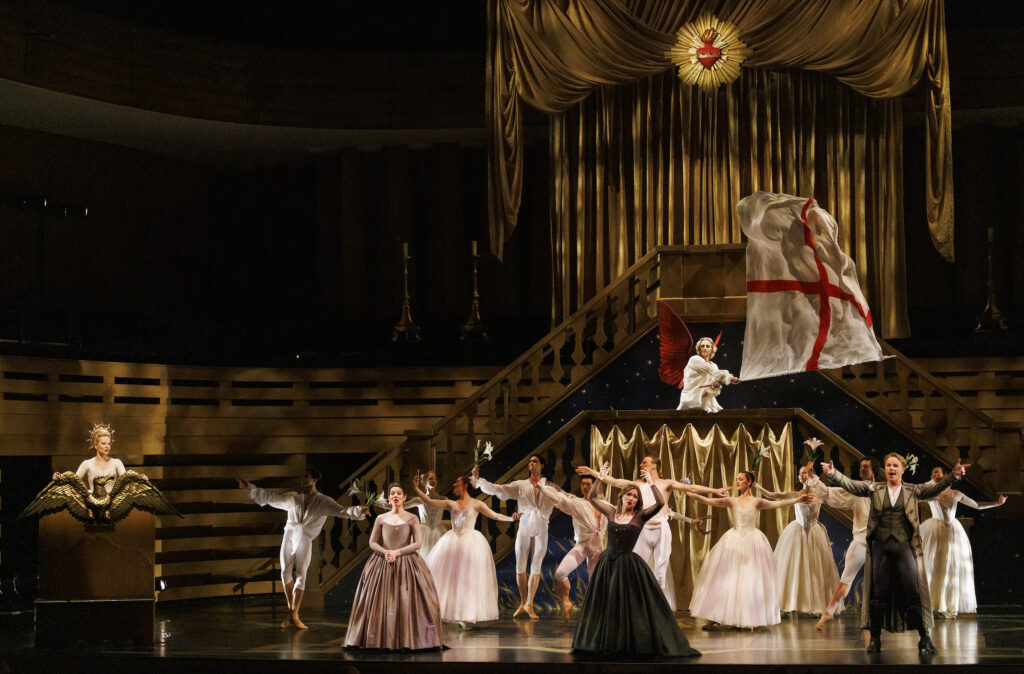Pandemic-cancelled in March 2020, memorably streamed in the form of a moody digital film in the spring of 2021, The Resurrection — Opera Atelier’s gloriously irrepressible account of George Frideric Handel’s formative oratorio currently on view at Koerner Hall — more than amply fulfills the promise of its title. Life everlasting is stunningly celebrated, golden and glowing. A triumph of reanimation from multiple perspectives.
Something of a quick-witted journeyman composer’s graduating thesis, first performed on Easter Sunday, April 8 1708 at the palace of influential Roman nobleman, the Marchese Francesco Maria Ruspoli, Handel’s musically lavish expression of Christianity’s fundamental tenet marked his arrival as master of stylish vocal settings and elaboration. Fashionable Italianate forms of the period keenly observed, intensely rendered displays of tumbled emotion showcased in any number of soaring da capo arias. An oratorio in name only, the experience and acclaim of The Resurrection would later serve Handel well in Italian opera-obsessed early 18th century London.
Opera, or rather an overarching sense of all things operatic, informs very nearly the entirety of director Marshall Pynkoski’s vision of Christ’s victory over death conveyed as both panorama and portrait, a raging theological battle of opposing pulpits, as witnessed quite literally on stage, tempered by a more earthly stream of affecting human vignettes.
Impassioned first-hand narratives form the basis of originating 18th century poet/librettist Carlo Sigismondo Capece’s profoundly emotional portrayal of boundless grief as three devoted followers of Jesus, Mary Magdalene, Mary of Cleophas — a somewhat enigmatic biblical mourner — and St. John the Evangelist struggle to process their loss in shared terms flashed with deeply private expressions of pain. The Magdalene sleepless and shattered. Cleophas anxious yet stoic. John brave and trusting. Pynkoski grants each a full measure of attention and respect before unleashing another swell in the virtually continuous tide of action that surges around his principals. A strutting, bombastic Lucifer dashes from the wings to cross verbal swords with a feisty, no-nonsense archangel. Wave on wave of divine spirits swirl through the drama.
Resident set designer Gerard Gauci’s towering monoset, a double-tiered assemblage of platforms and stairs custom-created to blend with the pre-existing aesthetic of Koerner Hall’s strictly defined stage, adds an impressive degree of monumentality to the proceedings. Frequently perched in its lofty heights, soloists and angels alike command instant attention, compelling visual punctuation points. Kimberly Purtell’s calculated low angled, two-dimensional lighting design adds an air of candlelit splendour. The Palazzo Ruspoli brought to life.
Choreography, an omnipresent source of narrative drive courtesy Jeannette Lajeunesse Zingg, vividly mirrors Pynkoski’s impulse to frame the sacred wonder of death defied in twofold dramatic terms. Sweeping revelation and intimate tenderness are jointly venerated, at times, simultaneously. What begins with a band of vigilant rapier-wielding angels ends in a celebration of ecstatic joy. A gentle winged harbinger of sleep, tenderly danced by Edward Tracz, yields to Mary Magdalene’s suffering. Dominic Who, movingly partnered by Zingg, gifts us with an exquisitely touching pas de deux, the Virgin Mary rejoicing in her reunion with her son become the Risen Christ. Elements of the universal — a mother’s suffering, love and loss — are elegantly, powerfully brought to the foreground. Artists of Atelier Ballet electrify, eloquent storytellers in dazzling perpetual motion.
Cast as Mary Magdalene, soprano Meghan Lindsay brings great compassion to the assignment, her voice shimmering and luminous, her encapsulation of anguish and desperation striking straight to the heart. Handel’s exquisite Ferma l’ali, e sui miei lumi/Non volar, o sonno ingrato! (“Fold thy wings, and o’er my eyes fly not, unwelcome sleep”) is delivered with enormous poignancy and pathos.
Mezzo-soprano Allyson McHardy sings Mary of Cleophas, lush and mellow-toned and masterfully attentive. Cleophas’ euphoric aria, Vedo il Ciel che più sereno/Si fa intorno e più risplende (“I see the skies turn to colour and shine ever brighter”), a vibrant outpouring of exuberance and relief as she realizes Christ lives, is positively rapturous.
Tenor Colin Ainsworth appears as St. John, all excitable dash and daring in his long flowing frock coat, his character’s invincible high spirits impelling his gorgeous ringing head voice to a place of no small wonder.
Bass Douglas Williams contributes a wicked Lucifer. Devilishly handsome, diabolically charismatic, Williams essentially owns the part, singing with great presence and poise, muscular, molten and dangerously alluring.
Soprano Carla Huhtanen is the Archangel, a formidable defender of spiritual wellness. Frequently partnered with Williams’ smug, supremely prideful Lucifer by way of counterpoint, Huhtanen tears into the role with a delicious sense of both playfulness and purpose, launching the evening with an explosive attack on evil — Disserratevi, o porte d’Averno (“Be unbarred, you gates of Hell”) — colortura blazing.
Leading a flawless, extended 24-player Baroque ensemble drawn from Tafelmusik, conductor David Fallis charts a steady course through Handel’s highly adventuresome score, navigating every thrilling compositional twist and turn with great dexterity. Harmonies are unfailingly resonant and bright, tempi crisp and well-considered, the orchestral balance perfect.
This is a richly detailed Resurrection, as elemental as it is reflective of the expanse of human emotion. A journey from darkness to light. From the natural order to the spiritual. A miraculous Resurrection. A masterpiece.


